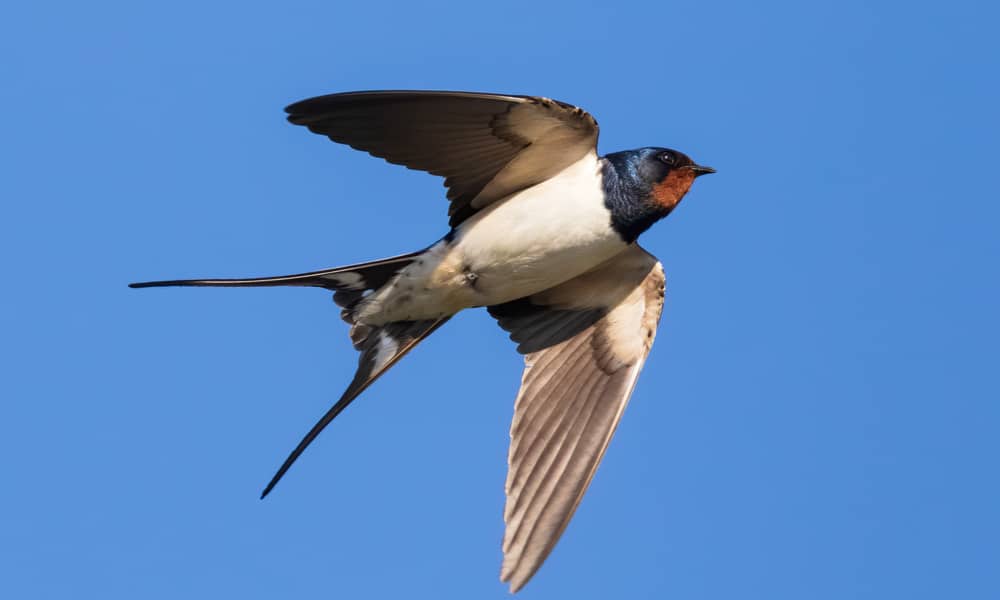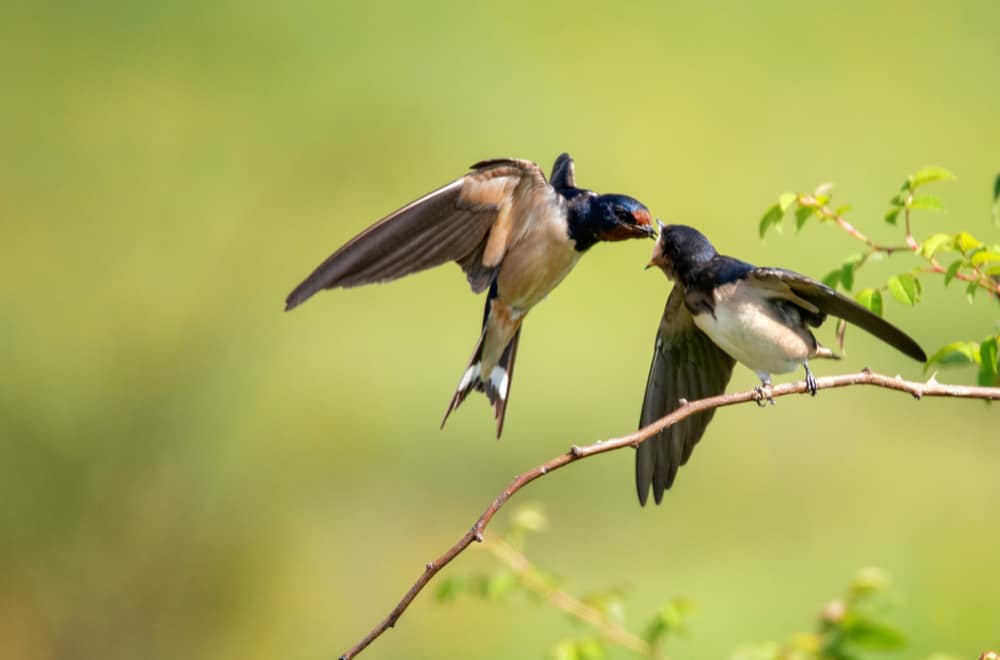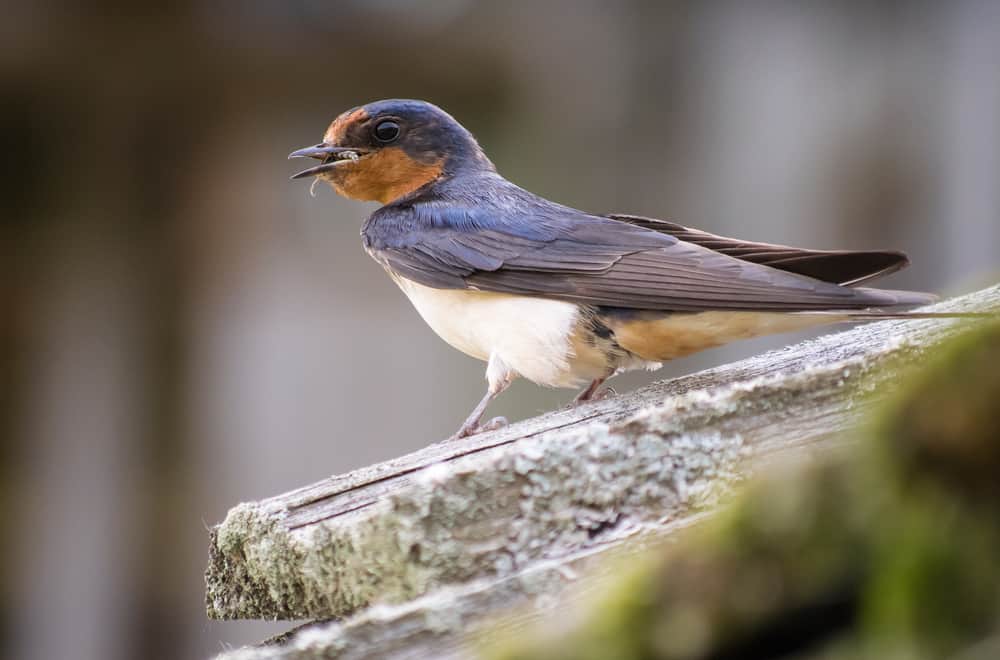Looking at a barn swallow, you would think it’s clad in a blue suit and orange dress shirt due to the color of its feathers. They are tiny songbirds usually associated with the coming of spring and distinguished from other birds by their forked tails.
So, what do barn swallows eat?
Barn Swallows Habits And Biology
Barn swallows are the most widespread swallow species worldwide.
Adult males are on average 17-19 centimeters long, including outer tail feathers of length 2-7 centimeters. They have wingspans of 32-35 centimeters long and weigh between 16-22 grams.
Their upper body parts are steel-blue in color, with a rufous (reddish-brown) throat and chin, separated from the off-white lower body parts. They have elongated tail feathers with a distinctive fork shape.
Female barn swallows are similar in appearance to their male counterparts, except for having shorter tails and a different shade of blue on their upper body.
Juvenile swallow barns are browner, and they have a paler rufous color. They lack the elongated tails adult birds have.
Both the male and female barn swallows sing although it was only recently that the female song was described. Their alarm calls are loud and sharp to warn other birds against predators like cats. That said, barn swallows are usually quiet during the winter seasons.
Barn swallows prefer to live in open country areas with low vegetation, such as meadows, farmland, and pasture. The existence of open structures such as stables and barns provides nesting sites.
Bare branches, ridges, and wires serve as perching areas and are vital in the bird’s selection of its breeding range.
Barn swallows are semi-colonial and settle in groups from a pair to a few dozen, typically in spacious wooden structures meant to house animals, such as goats, cows, horses, and chickens. These sites often serve as breeding grounds.
Male barn swallows select the nesting site, which it then advertises to the female with a song and circling flight. In some species, plumage (birds feathers) plays a role in choosing mates as males with darker feathers are associated with higher breeding success.
What Do Barn Swallows Eat?
Barn swallows are insectivorous birds and feed primarily on insects. It mainly feeds in open areas, 7-8 meters above shallow groundwater, often following humans, animals, or farm machinery to capture insects.
In other instances, it will catch prey from above water surfaces, plants, and walls. In their breeding areas, flies make up about 70% of their diets. Aphids also make a significant part of their diets.
Barn swallows often form large flocks when hunting for insects, whereas they tend to hunt in pairs when egg-laying. During winter, they primarily consume flying ants and feed on dead or sluggish insects on the ground.
The amount of food hatchlings (offspring) get depends on their numbers, where their parents will feed a higher number of hatchlings more.
Adult barn swallows will continue feeding their young even after a week of leaving the nest. When the young birds depart the nest, they perch on trees.
Barn swallows drink water by skimming low over water bodies like lakes and rivers and scooping up water using their beaks.
In gardens or backyards, they’re offered crushed oyster shells or eggshells to supplement their diets. Swallows get calcium from the shells and grit (e.g., soil or small stones) that aid in digestion.
Barn swallows feed on a wide variety of insects, and the following are the examples:
- House flies
- Horseflies
- Wasps
- Beetles
- Wild bees
- Winged ants
- True bugs
- Moths
- Grasshoppers
- Damselflies
- Spiders
- Snails
Barn swallows are essential to farms as they help get rid of pests that bother you while enjoying your time outdoors.
Facts About Barn Swallows
- Barn swallows are found worldwide except for Antarctica.
- In Canada, the barn swallow species are at threat of extinction. Their numbers have decreased by about 76% over the past forty years.
Researchers speculate the reduction is due to climate change, lost nesting, predators, and changes in the insect population. However, the real reason remains unknown.
- Barn swallows migrate over long distances, spending their winter in parts of South and Central America. Some have been found as far as Argentina.
- Barn swallow recycles nests. They build their nests using pellets of mud and reuse their nests for several years. New pairs of swallows will occupy unused nests as it is time and energy-consuming to construct a new one.
- The birds are very light in weight. As previously mentioned, they weigh about 17-20 grams, which is the equivalent of 7 or 8 pennies.
- Barn swallows often produce two broods of 4 or 5 eggs per year. Around 70-90% of these eggs will successfully raise one bird.
- In certain circumstances, barn swallows become territorial, primarily to protect their nests. They will start making alarm calls or dive-bombing if they perceive you as a threat.
- Barn swallows live for an average of 4 years. The oldest recorded barn swallow lived for 8 years in Maryland, USA.
- Male barn swallows help the females with nest building and feeding their young. They will also participate in the incubation of their eggs.
- Other barn swallows help raise their siblings’ offspring or members of their clutches (birds incubated together).
- Barn swallows mate while flying.
- Barn swallows are diurnal, and they carry out most of their activities throughout the day, including migration. They can travel for up to 600 miles a day, feeding in mid-air as they go.
- Barn swallows travel at speeds of 11meters per second in a zigzag manner. They often fly near the ground surface, where they obtain most of their food during flight.
- A group of swallows is known as ‘kettle.’
- In the past, barn swallows used cliffs and caves for the construction of their nests.
- Barn swallows may live in symbiotic relationships with ospreys (sea hawks) –they build their nests directly under the osprey’s nest. For this reason, the swallows are kept safe from other predators. In turn, the swallows’ alarm call to inform the osprey of incoming threats.
- Various governments, e.g., the American government, federally protect the barn swallow species. It is illegal to remove a swallow’s nest under construction or one already constructed, with or without its eggs.
- Barn swallows were once hunted and killed for their tail feathers. Consequently, this led to creating a law that makes it illegal to own a single tail feather.
- The barn swallow has links to Greek mythology. Legend has it that Procne (Athenian princess) was turned into a swallow by the gods to protect her from the king’s wrath (King Tereus of Thrace).
- Some ancient civilizations claim that the barn swallow’s tail is a result of punishment from the gods. It is said that the bird stole fire from the gods to bring it to people on earth. In anger, the gods shot fiery arrows at the bird, which burned the midsection of its tail feather.
- Sailors and youth of various generations tattoo the barn swallows on their bodies which represents eternal love, journey, trust, honor, new beginnings, hope, fortune, among other values.
- Barn swallows are the national bird of Estonia and Austria.
- Barn swallows are monogamous and will breed for life. However, in some cases, a single male can have up to two mates.
- Barn swallows are social birds; for example, one of their roosts contained up to 1.5 million birds in Nigeria.
- Barn swallows are one of the most represented birds on postage stamps worldwide.
- It takes about 1,200 trips for a pair of barn swallows to build their nest.
- Europe is thought to house the largest number of barn swallows in the world. There are around 15 million individual birds in total, with the most significant numbers being in Bulgaria and Poland.
- Male swallows are the first to arrive from migration, while females come a week or two later.
- Barn swallows will occupy artificial nests made to resemble their mud-built shelters.
- A lot of folklore surrounds the swallow. Spotting the first swallow of the year is considered a good omen in some cultures. Russian sang songs to celebrate their return after winter.
- Before people learned that they migrate, they thought swallows spent their winters buried in the mud of lakes and ponds.
- Numerous literary references are based on the birds’ northward migration as a sign of spring or summer. An example is in the following proverb coined by Aristotle: “For one swallow or one day does not make spring….”
- Unmated adults often associate themselves with breeding pairs. They help their parents to build and defend the nest and also in incubation. The ‘helpers’ are mainly male.
- The barn swallow diet includes about 80 different insect families.
- Outside the breeding season, some barn swallows may form large flocks or even roost communally. This behavior is thought to protect the birds against predators such as sparrowhawks.
- Swallows and swifts are in no way related despite their similarities in appearance.
- Some people call the swallows the “bird of freedom” because they can’t endure captivity and only mate in the wild.
Summary
Now that you know, “what do swallows eat?” attracting them to your yard shouldn’t be a problem.
These adorable birds of the sky spend the better part of their lives freely flying. Barn swallows are an inspiration to many, young and old, sailors and gods alike.


